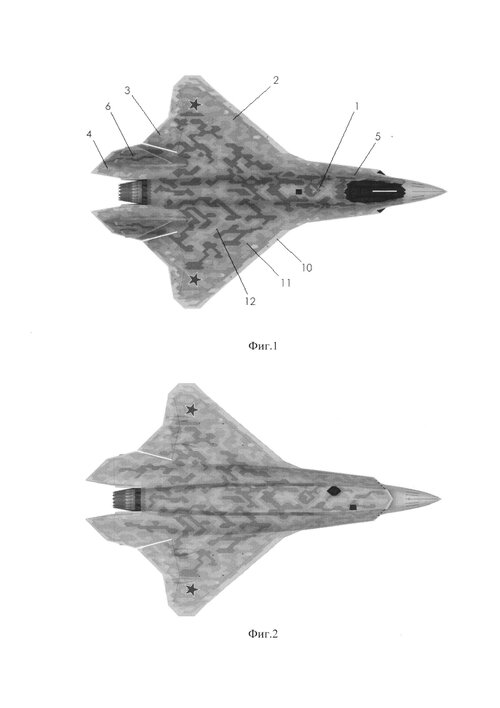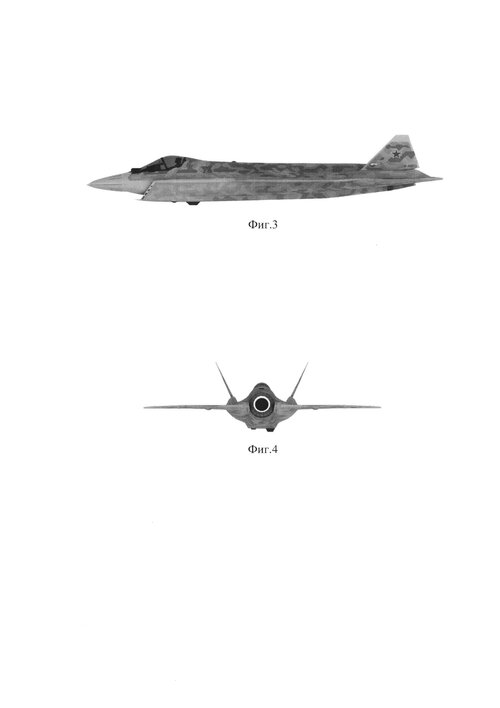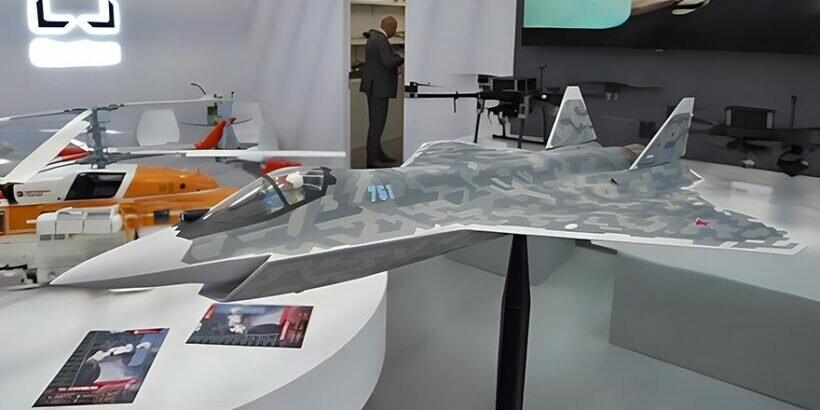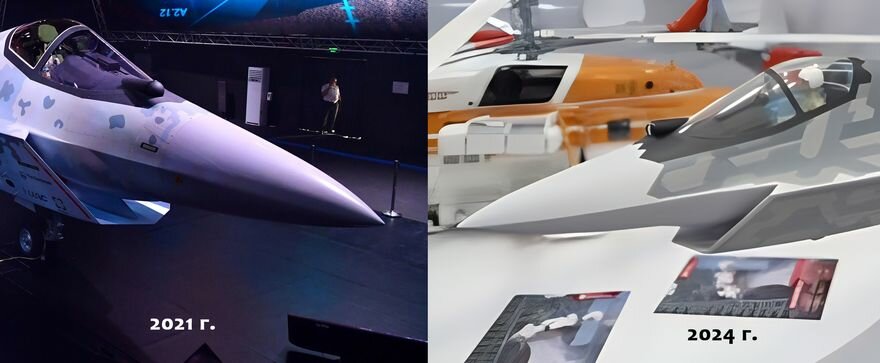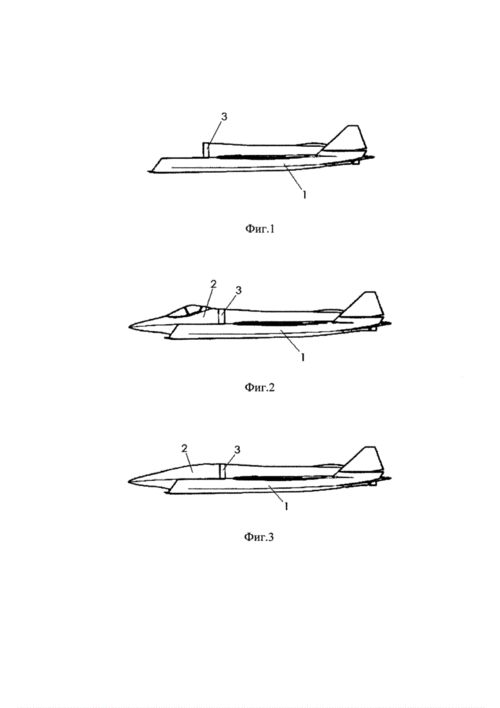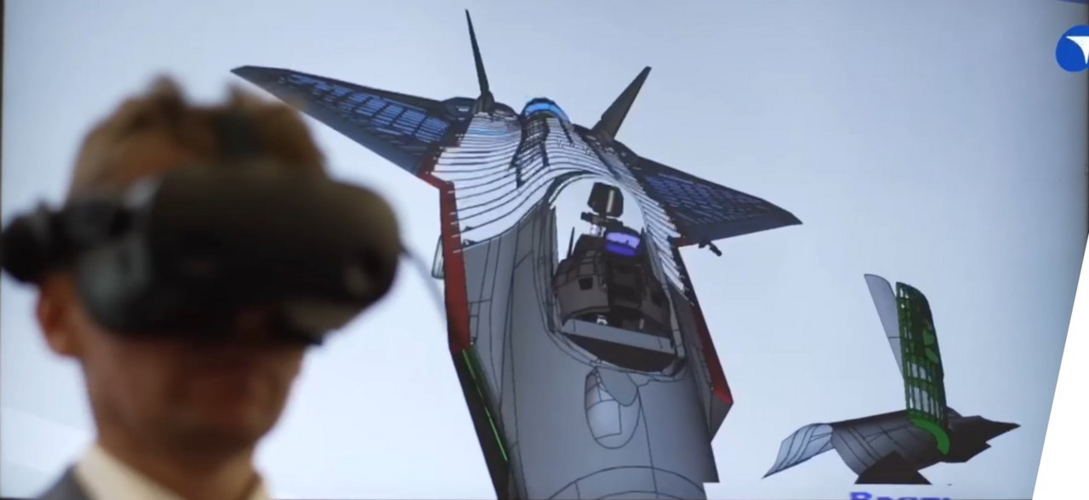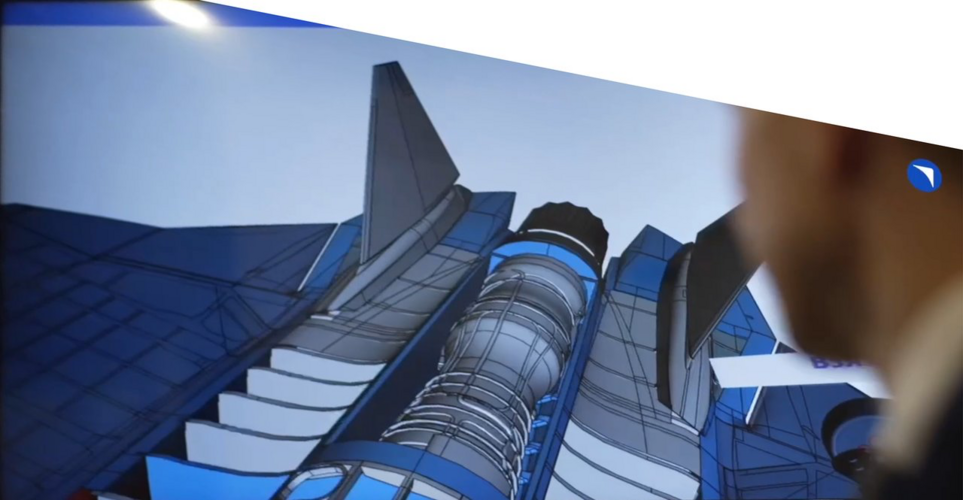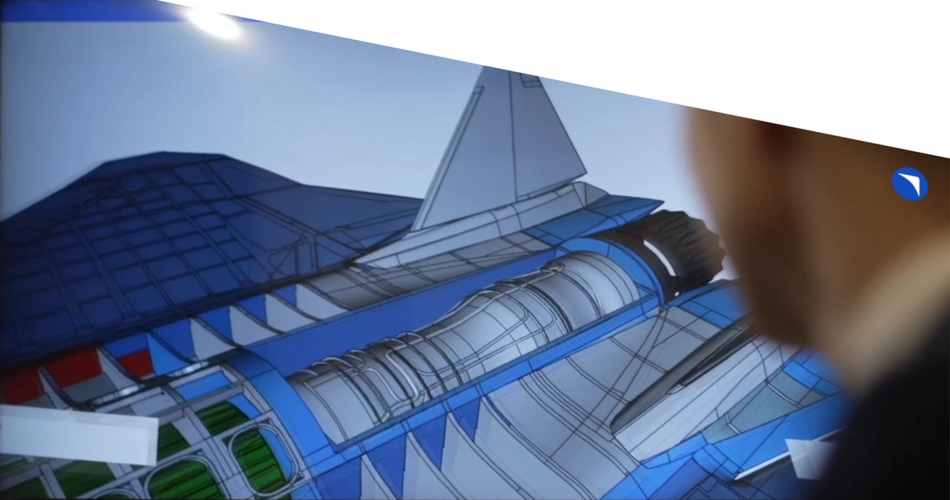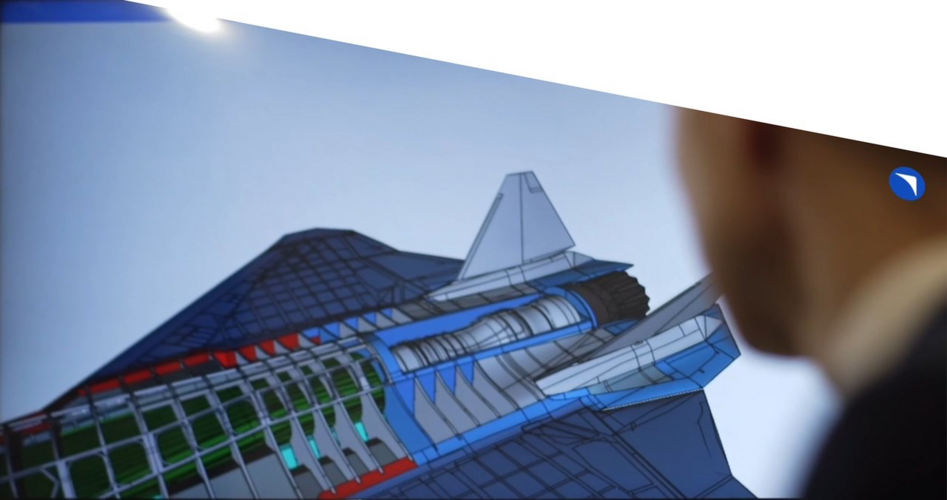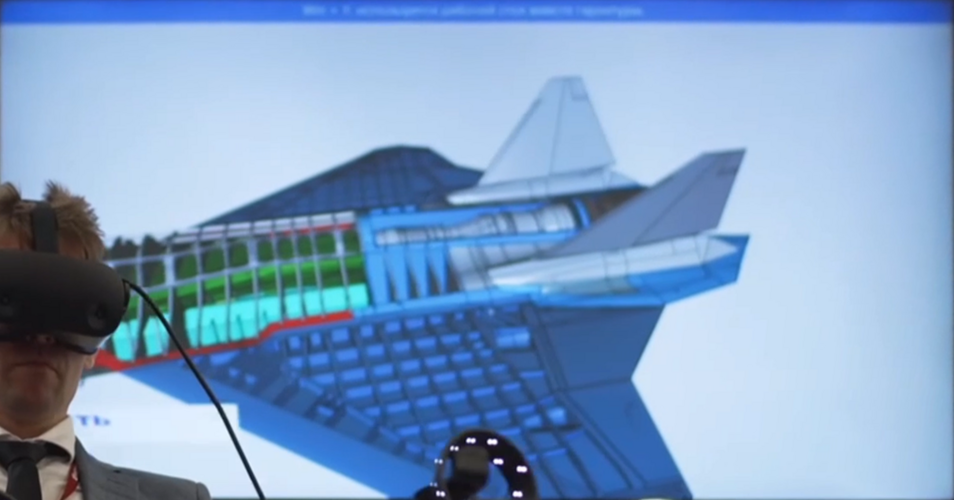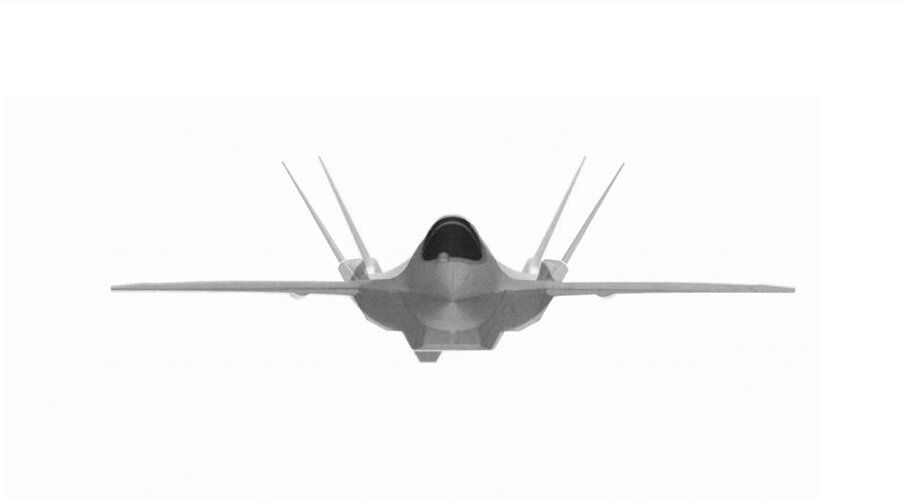Without dorsal MAWS.This is upgraded design model.
You are using an out of date browser. It may not display this or other websites correctly.
You should upgrade or use an alternative browser.
You should upgrade or use an alternative browser.
Sukhoi T-75 LTS (CheckMate)
- Thread starter sublight_
- Start date
- Joined
- 24 November 2008
- Messages
- 1,549
- Reaction score
- 2,612
Sukhoi Reshapes The Su-75 Checkmate | Aviation Week Network
The Russian aircraft company reveals a new design configuration developed using digital design.aviationweek.com
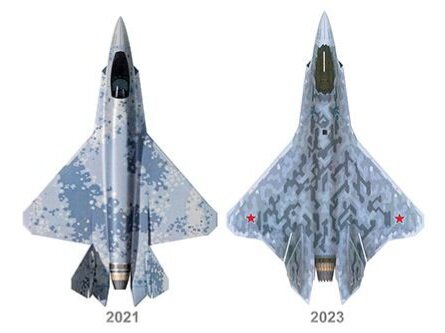
Avimimus
ACCESS: Top Secret
- Joined
- 15 December 2007
- Messages
- 2,426
- Reaction score
- 908
Upgraded over the already revised design that has been around since last year? Do you know of any notable changes?
Yes, I suppose building another mock-up wouldn't actually help anything.
New wing, new radome for starters, maybe more tapering along the spine as well.
I think I am safeI hope the Russians prove you wrong, GTX. It is one of the coolest new fighter designs I've seen in awhile imo.
FighterJock
ACCESS: Above Top Secret
- Joined
- 29 October 2007
- Messages
- 5,607
- Reaction score
- 5,934
I was wondering why Sukhoi went quiet in regards to the SU-75, I am liking the look of the new design of the Checkmate and like others on this thread cannot wait to see it fly.
Wing is the same. Only flaperones are different (and likely hydraulics).New wing, new radome for starters, maybe more tapering along the spine as well.
Radome also, IMO, is the same.
FighterJock
ACCESS: Above Top Secret
- Joined
- 29 October 2007
- Messages
- 5,607
- Reaction score
- 5,934
Just wondering if the bays will still be the same on the new design?
WatcherZero
ACCESS: Top Secret
- Joined
- 22 May 2023
- Messages
- 829
- Reaction score
- 1,935
FighterJock
ACCESS: Above Top Secret
- Joined
- 29 October 2007
- Messages
- 5,607
- Reaction score
- 5,934
India said no to the Su-57 when Russia tried to co-develop it, so India might or might not purchase the Su-75 but I suppose we will have to wait and see what happens.
snne
ACCESS: Top Secret
- Joined
- 3 July 2022
- Messages
- 1,388
- Reaction score
- 4,510
And they went on and bought the inherently inferior Rafale in stead just because it was urgent. I'm not against rip off the Rafale purchase by the way, it was just wrong to cancel Su-57 participation and then think they can replace it with modernized 4th gen fighters. They should've replaced the MKI with Su-57, now they have too many projects on their hands that even if they are realized they will be too little too late. I've even read that they didn't even pay for the development of FGFA. They were imo a bit arrogant to demand too many changes and also think they can get away with not contributing to the programme.India said no to the Su-57 when Russia tried to co-develop it, so India might or might not purchase the Su-75 but I suppose we will have to wait and see what happens.
If they had continued with the programme, they could've gained the technological upper hand against PAF much earlier. They could've accepted the base capabilities of the aircraft and had a local assembly or maybe even a production line. Even if it is clearly not a true 5th gen (4+ with some LO by my standards), its capabilities are not that bad either.
Acatomic
ACCESS: Secret
- Joined
- 18 October 2020
- Messages
- 244
- Reaction score
- 578
ИЗ №2800101
new.fips.ru
Patent of Checkmate's landing gear (and other stuff?).
Google translate is not working for me. So landing gear is the only part that i kinda understand that the patent talking about
One interesting thing about this patent (if I understood it correctly ) is that they don’t seem to be too happy with the maintenance and manufacturability of Su-57 - or at least they weren’t too happy. Below:
The technical solutions adopted in the analogues do not allow to ensure a sufficient level of operational manufacturability and are characterized by increased labor intensity and maintenance time. There is no convenient approach to the niches of the main supports (supports) of the chassis (PSO), where the maintenance units are located. The process of installation and dismantling of the engine is time-consuming and is provided with the use of additional devices for the upper surfaces. The production hatches have a large number of fasteners characterized by the most time-consuming process of opening/closing hatches, which leads to an increase in the duration of dismantling and installation of service hatch covers. The dense layout of the blocks and assemblies on board the aircraft leads to the need to dismantle neighboring blocks and units during maintenance and troubleshooting. To dismantle the power plant, partial dismantling of power elements (section of the frame) is required.
The technical task aimed at achieving the invention is to eliminate the shortcomings of aircraft known from the level of technology and to create a light tactical aircraft characterized by ease of use and with the least time-consuming and lengthy aircraft maintenance operations.
The technical result of the claimed invention is to improve the convenience and safety of technical operation and maintenance of a light tactical aircraft, including in troubleshooting, as well as reducing the time for these activities.
WatcherZero
ACCESS: Top Secret
- Joined
- 22 May 2023
- Messages
- 829
- Reaction score
- 1,935
And they went on and bought the inherently inferior Rafale in stead just because it was urgent. I'm not against rip off the Rafale purchase by the way, it was just wrong to cancel Su-57 participation and then think they can replace it with modernized 4th gen fighters. They should've replaced the MKI with Su-57, now they have too many projects on their hands that even if they are realized they will be too little too late.
India said when they cancelled it in 2018 the performance of the SU-57 didnt live up to India's technical requirements and that's why they cancelled it. According to the India Business Standard at the time low-observable characteristics were its biggest technical shortcoming.
snne
ACCESS: Top Secret
- Joined
- 3 July 2022
- Messages
- 1,388
- Reaction score
- 4,510
Do Rafale, Tejas Mk.2, TEDBF and possibly first couple dozen AMCAs have lower RCS than even the current Su-57? I'm not even talking about how the Felon would be ready and would've already gone through the Su-57M mod.India said when they cancelled it in 2018 the performance of the SU-57 didnt live up to India's technical requirements and that's why they cancelled it. According to the India Business Standard at the time low-observable characteristics were its biggest technical shortcoming.
Yes, it has inferior LO characteristics compared to true 5th gen designs but the aircraft itself isn't that bad. It has long range, deep internal weapon bays, long range sensors amd faster cruise speed (or high supercruise with AL-51F1). It also has some degree of RCS reduction which is a big bonus compared to 4+ (or as I call it, modernized 4th gen) arcraft.
They wanted out for some reason and "not meeting requirements" was admittedly just the perfect excuse for them.
Last edited:
TMA1
ACCESS: Top Secret
- Joined
- 6 February 2021
- Messages
- 556
- Reaction score
- 857
They want their own strong aviation industry. They have to start somewhere. Another is that we are putting a lot of pressure across the globe to decrease Russian weapon export sales. Even us buying out stocks of soviet weapons to send to Ukraine has an impact in this.
snne
ACCESS: Top Secret
- Joined
- 3 July 2022
- Messages
- 1,388
- Reaction score
- 4,510
Hence:They want their own strong aviation industry. They have to start somewhere. Another is that we are putting a lot of pressure across the globe to decrease Russian weapon export sales. Even us buying out stocks of soviet weapons to send to Ukraine has an impact in this.
They should've replaced the MKI with Su-57, now they have too many projects on their hands that even if they are realized they will be too little too late. I've even read that they didn't even pay for the development of FGFA. They were imo a bit arrogant to demand too many changes and also think they can get away with not contributing to the programme.
Avimimus
ACCESS: Top Secret
- Joined
- 15 December 2007
- Messages
- 2,426
- Reaction score
- 908
If you guys want to debate what constitutes a 5th generation fighter or want to try to figure out why the FGFA deal actually collapsed - there are other threads for that.
I suspect that this paragraph refers to a number of different types of modern aircraft. A big push with the LTS is to have rapid turn-around times, limited airfield infrastructure, and ease of maintenance (without extensive specialised training)... so they might be trying to outdo several 4th generation designs as well.
If I understood it correctly, one of the advertised features was having diagnostics and predictive maintenance actually carried onboard the airframe (i.e. the maintenance scheduling can be managed by an onboard computer)!
So the idea that it also includes a quick drop-out engine bay, and arrangement of systems to allow opening a few large panels for most tasks (rather than a more complex strip down), is quite consistent with this overall goal.
One interesting thing about this patent (if I understood it correctly ) is that they don’t seem to be too happy with the maintenance and manufacturability of Su-57 - or at least they weren’t too happy. Below:
I suspect that this paragraph refers to a number of different types of modern aircraft. A big push with the LTS is to have rapid turn-around times, limited airfield infrastructure, and ease of maintenance (without extensive specialised training)... so they might be trying to outdo several 4th generation designs as well.
If I understood it correctly, one of the advertised features was having diagnostics and predictive maintenance actually carried onboard the airframe (i.e. the maintenance scheduling can be managed by an onboard computer)!
So the idea that it also includes a quick drop-out engine bay, and arrangement of systems to allow opening a few large panels for most tasks (rather than a more complex strip down), is quite consistent with this overall goal.
Scott Kenny
ACCESS: USAP
- Joined
- 15 May 2023
- Messages
- 11,628
- Reaction score
- 14,324
This was also a big part of the F-35 contract. No part could be hidden behind something else, they all had to be the first thing once you opened a panel.I suspect that this paragraph refers to a number of different types of modern aircraft. A big push with the LTS is to have rapid turn-around times, limited airfield infrastructure, and ease of maintenance (without extensive specialised training)... so they might be trying to outdo several 4th generation designs as well.
If I understood it correctly, one of the advertised features was having diagnostics and predictive maintenance actually carried onboard the airframe (i.e. the maintenance scheduling can be managed by an onboard computer)!
So the idea that it also includes a quick drop-out engine bay, and arrangement of systems to allow opening a few large panels for most tasks (rather than a more complex strip down), is quite consistent with this overall goal.
As seen on some previous pics intake shape changed as well
In the 2021 version of the project, it is divided into two channels and its lower corner part slightly protrudes in the direction of flight. On the model, which UAC brought to Riyadh, there is no such division, the air channel is one without a bulkhead at the flow inlet, and the bottom of the air intake is straight.
In the 2021 version of the project, it is divided into two channels and its lower corner part slightly protrudes in the direction of flight. On the model, which UAC brought to Riyadh, there is no such division, the air channel is one without a bulkhead at the flow inlet, and the bottom of the air intake is straight.
Attachments
Last edited by a moderator:
Interchangeable cockpit section patent
 new.fips.ru
new.fips.ru
ИЗ №2807558
Attachments
Last edited by a moderator:
- Joined
- 1 April 2006
- Messages
- 11,394
- Reaction score
- 10,286
Lower lip has the same wedge as original configuration.As seen on some previous pics intake shape changed as well
CGI?
QuadroFX
Russia, Chelyabinsk
No, it is from the same photoset as this one:CGI?

T-75_gigapixel_tiles-standard-scale-2_00x-gigapixel.png
Посмотреть и скачать с Яндекс Диска
 disk.yandex.ru
disk.yandex.ru

Russian new cheap stealth fighter SU-75 facing massive export issue | Defense News April 2024 Global Security army industry | Defense Security global news industry army year 2024 | Archive News year
Russian new cheap stealth fighter SU-75 facing massive export issue, depending of internal malfuncions
Acatomic
ACCESS: Secret
- Joined
- 18 October 2020
- Messages
- 244
- Reaction score
- 578
TMA1
ACCESS: Top Secret
- Joined
- 6 February 2021
- Messages
- 556
- Reaction score
- 857
I know the image appears stretched because of its format but I think it is pretty clear that the verticle stabilizers have been pretty drastically reduced in size. In fact the new su-75 variant seems like it has incorporated elements similar to some of the current european sixth gen designs. I very much hope the ruskies finish development even if only for themselves. It is very lovely.
Scott Kenny
ACCESS: USAP
- Joined
- 15 May 2023
- Messages
- 11,628
- Reaction score
- 14,324
Sukhoi does build very aesthetically-pleasing aircraft.I very much hope the ruskies finish development even if only for themselves. It is very lovely.
So the dream of having parts commonality with the Su-57 is slowly slipping away. I wonder where have we seen that before?I know the image appears stretched because of its format but I think it is pretty clear that the verticle stabilizers have been pretty drastically reduced in size. In fact the new su-75 variant seems like it has incorporated elements similar to some of the current european sixth gen designs. I very much hope the ruskies finish development even if only for themselves. It is very lovely.
As far as i can see, the wing is still common with Su-57. It's just the elevons that changed. Reduced vertical stabilizers, as well, might be just an upper section of those used on Su-57.So the dream of having parts commonality with the Su-57 is slowly slipping away. I wonder where have we seen that before?
Avimimus
ACCESS: Top Secret
- Joined
- 15 December 2007
- Messages
- 2,426
- Reaction score
- 908
As far as i can see, the wing is still common with Su-57. It's just the elevons that changed. Reduced vertical stabilizers, as well, might be just an upper section of those used on Su-57.
Or one could go the other way - have the Su-57M receive reduced size rudders (as seems to have been the case in early concepts for it)
Correct me if I'm wrong, but at high AoA, those tiny rudders would get no airflow on top of them (nor would any other control surface). If you want to maintain control authority, you need those. Probably not a huge requirement for the Su-75, as its not going to be a highly agile dogfighter.Or one could go the other way - have the Su-57M receive reduced size rudders (as seems to have been the case in early concepts for it)They'd just need to figure out how to not need them.
FighterJock
ACCESS: Above Top Secret
- Joined
- 29 October 2007
- Messages
- 5,607
- Reaction score
- 5,934
I tend to think of the Su-75 as a Russian equivalent to the F-35, a more affordable variant to the Su-57 so manoverability is not going to be an issue if all you are carrying is air to surface guided munitions and only carry R-77 and R-73 for the rare occasions when they are needed.
Avimimus
ACCESS: Top Secret
- Joined
- 15 December 2007
- Messages
- 2,426
- Reaction score
- 908
I tend to think of the Su-75 as a Russian equivalent to the F-35, a more affordable variant to the Su-57 so manoverability is not going to be an issue if all you are carrying is air to surface guided munitions and only carry R-77 and R-73 for the rare occasions when they are needed.
There is no particular reason why it couldn't carry an R-37 class missile (I-810), except perhaps not having a powerful enough radar. As a drone wingman to a Su-57 it could probably carry two internally.
The existence of HOB missiles removes a lot of the WVR manoeuvrability requirements - although the Su-57 seems engineered for WVR a lot of its manoeuvrability may be sustained turns at speed (to increase survivability against BVR weapons)... but having a somewhat reduced capacity in that regard isn't necessarily something that prevents air-to-air use.
A bit dated but the following is a reaction from a former US fighter pilot to the Su-75. Is quite interesting to get the 'live' analysis:
View: https://youtu.be/XierKw1eR1o?si=5_chZvcJuc_iNTyi
- Joined
- 27 December 2005
- Messages
- 17,748
- Reaction score
- 26,414
ИЗ №2800101
new.fips.ru
Patent of Checkmate's landing gear (and other stuff?).
Google translate is not working for me. So landing gear is the only part that i kinda understand that the patent talking about
The invention relates to the field of aviation, namely to multifunctional single-engine supersonic aircraft.
A multi-mode highly maneuverable aircraft with an integral aerodynamic configuration is known (patent RU 2400402, published 09.27.2010, IPC V64S 30/00, V64S 1/22), containing a fuselage, the middle part of which is smoothly coupled with swept wing consoles, the head and tail of the fuselage, an all-moving vertical and horizontal tail in the rear fuselage. The aircraft is characterized by the fact that the middle part of the fuselage is integrated with the wing center section and is flattened in the vertical direction, and its outer surface in the longitudinal direction is formed by a set of aerodynamic profiles with high construction heights, ensuring the placement of built-in cargo compartments inside the fuselage, while the upper surface of the fuselage is made conjugate with the outer surface of the canopy and expanding in the area from the canopy to the rear of the aircraft fuselage with a decrease in curvature.
An aircraft with an integral aerodynamic layout is known (patent RU 2440916, published 01/27/2012, IPC B64D 27/20, B64D 33/02), containing a fuselage, a wing, the consoles of which are smoothly coupled with the fuselage, horizontal and vertical tail surfaces, a twin-engine power plant, characterized by that the fuselage is equipped with a bead located above the entrance to the engine air intakes and including controlled rotating parts, while the middle part of the fuselage is flattened and formed longitudinally by a set of aerodynamic profiles, the engine nacelles are spaced apart horizontally, and the engine axes are oriented at an acute angle to the plane of symmetry of the aircraft in the direction of flight.
A multifunctional aircraft with reduced radar signature is known (patent RU 2502643, published 12/27/2013, IPC B64D 7/00, B64D 27/16, containing an airframe, a twin-engine power plant and a set of on-board equipment.
A supersonic aircraft with intra-fuselage cargo compartments is known (patent RU 2583824, published 05/10/2016, IPC B64D 7/08, B64C 30/00), containing a fuselage in the lower part of which large longitudinal cutouts are made for tandemly located cargo compartments.
The technical solutions adopted in analogues do not provide a sufficient level of operational manufacturability and are characterized by increased labor intensity and duration of maintenance. There is no convenient access to the niches of the main landing gear supports (supports), where maintenance units are located. The process of installing and dismantling the engine is labor-intensive and is achieved with the use of additional devices for the upper surfaces. There are a large number of fastening elements on service hatches, which are characterized by the most labor-intensive process of opening/closing hatches, which leads to an increase in the duration of dismantling and installation of service hatch covers. The dense arrangement of blocks and assemblies on board the aircraft leads to the need to dismantle adjacent blocks and assemblies during maintenance and troubleshooting. To dismantle the power plant, partial dismantling of the power elements (frame sections) is required.
The technical problem to which the invention is aimed is to eliminate the shortcomings of aircraft known from the prior art and create a light tactical aircraft that is easy to operate and has the least labor-intensive and time-consuming aircraft maintenance operations.
The technical result of the claimed invention is to increase the convenience and safety of technical operation and maintenance of a light tactical aircraft, including troubleshooting, as well as to reduce the time required to carry out these activities.
The given technical result is achieved by the present invention. A multifunctional single-engine supersonic aircraft contains a fuselage, a wing, a power plant, a canopy with a pneumatic opening system, landing gear supports located in niches, hydraulic and electrical supply systems, maintenance units located in support niches, and on-board equipment located in compartments inside the fuselage. The aircraft is characterized by the fact that the aircraft service units for refueling fuel and oil, connecting a ground source of air conditioning and power supply, ground preparation of weapons, control of cargo compartment doors, grounding and a ground intercom are located in the niches of the left and/or right main landing gear with access to without the use of additional means, the doors of the landing gear niches are installed with the possibility of opening them to the axis of symmetry of the aircraft, while the avionics units that require a high frequency of maintenance activities are located in compartments inside the fuselage, behind the right and/or left niche the landing gear support in the direction of movement of the aircraft with the possibility of human access without the use of additional means and are closed by the covers of the operational hatches using quarter-turn locks of the cover fastenings, and the design of the aircraft is made in such a way that dismantling the power plant does not require the dismantling of other power elements of the aircraft.
The aircraft is additionally characterized by the fact that the oxygen filling system, the filling system for the pneumatic system for opening the canopy and emergency landing gear, the technological connectors of the on-board equipment are located in the niche of the front landing gear, and the switchgear and contactor boxes are located in the upper part of the niche of the landing gear with the possibility of human access without the use of additional funds.
The invention is illustrated by drawings.
Figure 1 shows a view of the landing gear and aircraft maintenance units (example), located in its niche, where 1 is the connection point for a ground-based power supply source, 2 is the connection point for a ground-based air conditioning source, 3 is a ground-based weapons preparation console, 4 is a control panel. cargo compartment doors, 5 - closed engine oil filling fitting, 6 - centralized fuel filling fitting.
Figure 2 shows a front view of the aircraft, where 7 - the doors of the right and left niches of the main landing gear are presented in the open position.
The niches of the right and left main landing gear of the aircraft are closed in flight by flaps. On the ground, these doors are always in the open position. In the proposed technical solution, the doors of the right and left landing gear niches open to the axis of symmetry of the aircraft, which provides a convenient approach for the specialist to the niche and improves the safety and convenience of aircraft maintenance.
Before performing assigned tasks, the aircraft undergoes pre-flight training, during which the specialist each time needs access to the appropriate aircraft maintenance units.
In the proposed technical solution, aircraft maintenance units (refueling engine fuel and oil, connection point for a ground source of air conditioning, power supply, grounding, ground intercom, ground weapons preparation, control of cargo compartment doors, etc.) are located in the niches of the right and left landing gear at a height , allowing a specialist to conveniently access them from the ground without the use of additional means (from a height of human height). The height interval is from 1.7 to 1.9 m. During operational maintenance, all the necessary aircraft maintenance units are located in places that do not require opening the service hatches and are not equipped with other closing elements.
Some of the aircraft maintenance units (refueling the pneumatic system for opening the canopy and emergency landing gear, refueling and monitoring the oxygen system, technological connectors for on-board equipment) are located in the niche of the front landing gear. The proposed arrangement of maintenance units reduces the duration of work and reduces the labor intensity of maintenance and increases ease of use in general.
As part of periodic aircraft maintenance, diagnostics, repair or replacement of units and assemblies of aircraft systems is required. The aircraft layout also provides for the placement of aircraft units and assemblies depending on their operational reliability and the frequency of maintenance activities.
The aircraft units and assemblies that have the greatest wear during operation and require periodic replacement or require high frequency maintenance (for example, as part of pre-flight preparation or post-flight maintenance) are provided with the fastest and most convenient access with a significant reduction in operating time. For example, DC circuit breakers are easy to access.
In the proposed technical solution (not shown in the drawings), avionics units that require a high frequency of diagnostic, maintenance or repair activities are located inside the fuselage, accessed through the service hatch behind the niche of the right and/or left landing gear in the direction aircraft movements, without the use of additional means, from a height of human height, height interval from 1.7 to 1.9 m.
The service hatch, with the specified avionics units located inside, is closed with a lid using quarter-turn locks for closing/opening. The use of quarter-turn locks made it possible to reduce the total number of fasteners by increasing the step of their installation, as well as reduce the labor intensity of opening/closing hatches and increase the speed of technical operations.
To carry out maintenance activities, it is not necessary to dismantle the on-board equipment units; it is enough to connect to the technological connector located in the niche of the front support. And to implement repair maintenance activities for units, it is not necessary to dismantle adjacent units and assemblies of other aircraft systems. This solution for avionics units also reduces the duration and complexity of maintenance and increases ease of use in general.
The layout of aircraft system elements, in particular the power supply system (PSS), provides a convenient approach to servicing systems during technical operation. Units of the power supply system (switchgear and contactor boxes), requiring constant inspection and monitoring, are located in the upper part of the OSH niche and have free access.
The proposed design and layout of the aircraft also allows for quick and convenient installation and dismantling of the engine. The aircraft is designed in such a way that dismantling the power plant does not require dismantling other power elements of the aircraft. Dismantling of the power plant is carried out in the “back and down” direction using a specialized trolley containing a carriage and a mechanism for engaging and transporting the engine.
Claim
1. Multifunctional single-engine supersonic aircraft containing a fuselage, wing, power plant, canopy with a pneumatic opening system, landing gear supports located in niches, hydraulic and electrical supply systems, maintenance units located in support niches, on-board equipment located in compartments inside the fuselage , characterized in that the aircraft service units for refueling fuel and oil, connecting a ground source of air conditioning and power supply, ground preparation of weapons, control of cargo compartment doors, grounding and a ground intercom are located in the niches of the left and/or right main landing gear with access to without the use of additional means, the doors of the landing gear niches are installed with the possibility of opening them to the axis of symmetry of the aircraft, while the avionics units that require a high frequency of maintenance activities are located in compartments inside the fuselage, behind the right and/or left niches landing gear supports in the direction of movement of the aircraft with the possibility of human access without the use of additional means and are closed by the covers of the operational hatches using quarter-turn locks of the cover fastenings, and the design of the aircraft is made in such a way that dismantling the power plant does not require the dismantling of other power elements of the aircraft.
2. Multifunctional single-engine supersonic aircraft according to claim 1, characterized in that the oxygen filling system, the filling system for the pneumatic system for opening the canopy and emergency landing gear, and the technological connectors of the on-board equipment are located in the niche of the front landing gear.
3. Multifunctional single-engine supersonic aircraft according to claim 1, characterized in that the switchgear and contactor boxes are located in the upper part of the landing gear niche with the possibility of human access to them without the use of additional means.
snne
ACCESS: Top Secret
- Joined
- 3 July 2022
- Messages
- 1,388
- Reaction score
- 4,510
Wouldn't it make more sense to develop a flying wing wingman for the Su-57, which would be inherently stealthier than a design based on a manned jet and thus easier to detect and shoot downThere is no particular reason why it couldn't carry an R-37 class missile (I-810), except perhaps not having a powerful enough radar. As a drone wingman to a Su-57 it could probably carry two internally.
- longer range and duration
- significantly lower RCS and easier to make (V)LO than a drone based on a manned jet
- possibly deeper/more voluminous bays
- could be used as a forward sensor or missile truck (since it is harder to detect)
- may not need as much RAM as a fighter design to achieve mission success (since most of LOity is based on the shape)
- easier to make more cost-effective
- is attritable, even if it gets shot down; you won't lose a pilot and you can actually afford a replacement
Similar threads
-
MAKS 2021 Airshow General News Topic
- Started by overscan (PaulMM)
- Replies: 35

